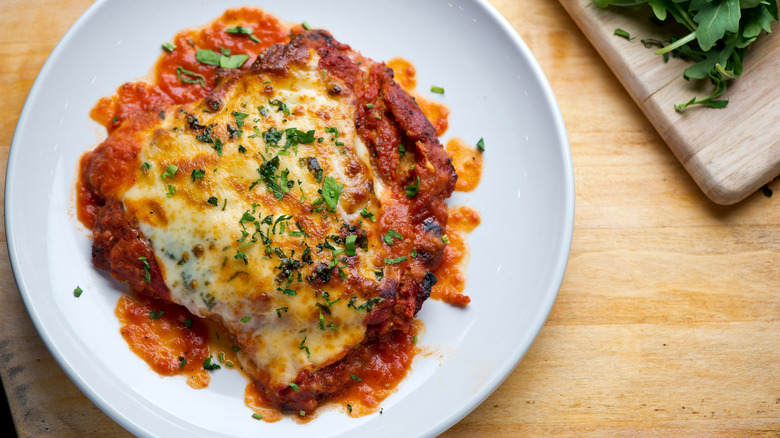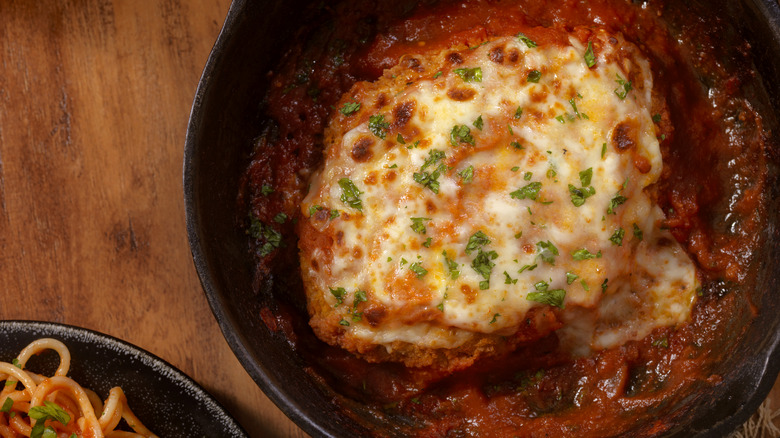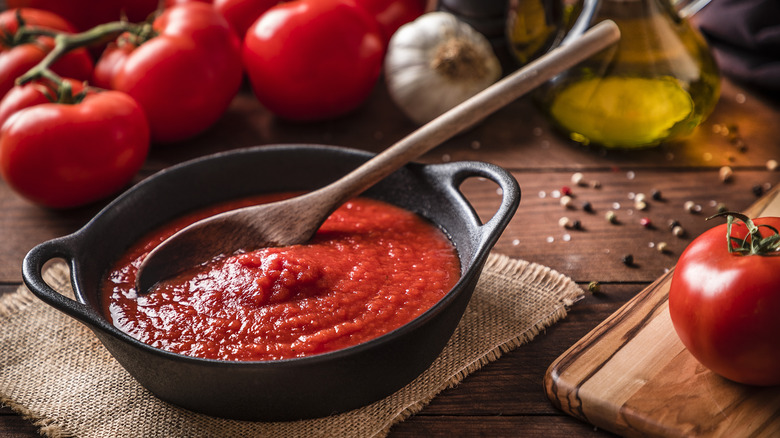How To Tell If A Chicken Parm Will Be Disappointing Before You Order It
Chicken parm, chicken parmigiana, chicken parmesan — whatever you call it, this dish stands as a formidable comfort food in Italian-American cuisine, thanks to its tantalizing and hearty combination of breaded chicken, tomato sauce, and cheese. While the recipe may not call for an elaborate list of 100-plus ingredients, that doesn't mean that every restaurant will always get it right.
If you're planning to order chicken parm at a restaurant, make sure you're choosing a place likely to do a good job. Typically, a classic red-sauce Italian joint is more likely to do it well, as opposed to, say, a sports bar. Of course, there are grey areas here: For example, a non-Italian restaurant with a reputation for great comfort food might also do a good parm.
Ideally, you should be able to detect the warning signs of a mediocre chicken parm dish from its menu description. Try looking up a restaurant's menu to check if they use ideal ingredients, like fresh mozzarella cheese, rather than the bagged shredded stuff. Menus don't always offer specific details like this, so it may be worth checking out some photos from past visitors, or reading some online reviews. Additionally, once you're at the restaurant, you can ask the server for more information about the dish or even peek into an open kitchen, if possible.
What to look for before you go
Beyond simply picking the right restaurant, finding a good chicken parm may require some research before you dine. Photos are a good starting point: Try to find some realistic images of the chicken parm you're targeting. Official photos from the restaurant could be carefully stylized, so it's often wiser to look for customer photos, perhaps on Google Reviews or Yelp.
If you can find these photos, there are a few details to look for. First, consider the chicken: Pretty much all reputable recipes agree that chicken parmesan should be made with breast meat or cutlets, which refer to thinly-cut chicken breasts. Boneless thighs could offer a flavorful alternative, but any other cut, like legs or (gasp) ground meat, is not a good sign. The lean breast meat pairs better with the breading, frying, and fatty cheese that will top the dish.
Next, check whether the chicken appears crispy. While it's difficult to deduce finer cooking details from a photo, a crispy exterior on the chicken is what you want to see. You'll also want to check out the cheese. Is it melted properly, or does it look stringy and a slightly too solid? (You want the former, not the latter.) It's harder to evaluate the tomato sauce from a photo, but you can at least check for a good balance in the dish. If the chicken is positively drowning in sauce, that's probably a red flag for a soggy parm.
What to look for at the restaurant
Once you arrive at the restaurant, put your chicken parm detective skills to work by asking about the ingredients and the cooking method for the dish, if these details aren't already made clear from the menu description. Ideally, your server should be able to tell you what cut of chicken the restaurant uses — you want breast, cutlets, or boneless thighs — and how the chicken is cooked. If the chicken is breaded and fried, you're in the clear. Some calorie-conscious versions of chicken parm are breaded and baked, but if you're seeking a traditional taste, a baked dish might disappoint.
If possible, try to find out what's in the tomato sauce. Green flag ingredients include aromatics like onion and garlic, as well as herbs such as basil and oregano. If the restaurant's red sauce strays too far from this formula — for example, if it includes unusual herb choices like mint — that's a red flag. Next, inquire about the type of cheese used in the dish. Fresh and creamy mozzerella is ideal, as is Parmesan in the breading or sprinkled on top. Anything else is a no-no.
Lastly, if you're bold enough to request a peek into the restaurant's kitchen, watch for a couple of other warning signs: Jarred tomato sauce and boxed breadcrumbs are not ideal. Fresh ingredients are always better. Of course, you could ask the server, but they may not admit to the use of such store-bought items.



